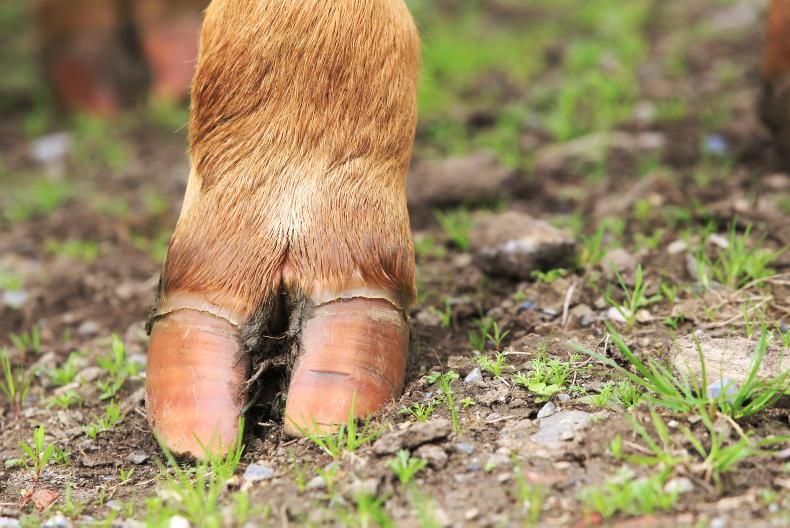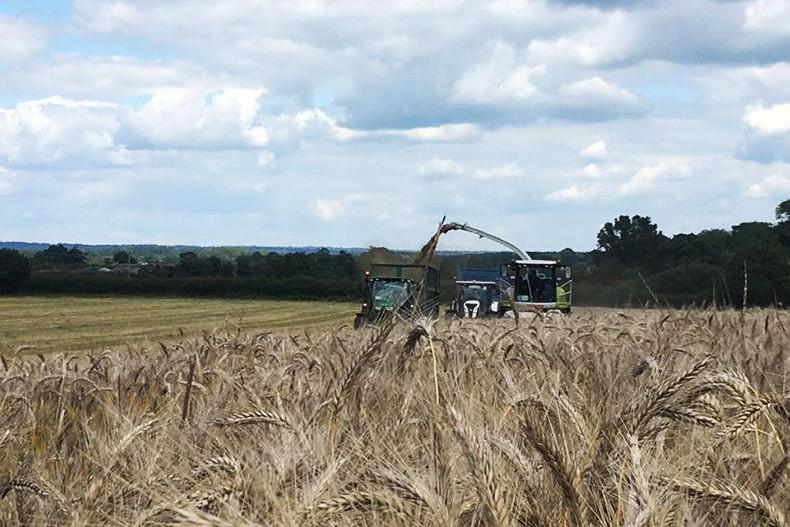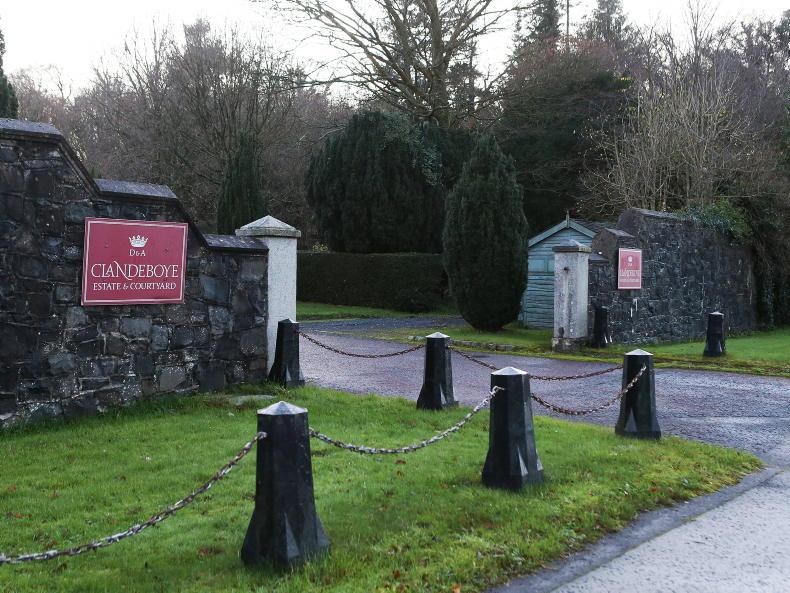I did a lot of my growing up in East Anglia. The long horizons and big cold skies of the east of England formed the backdrop to my years at agricultural college, and there is still something of a sense of homecoming when I find myself driving through the expansive, gently undulating cornfields of Cambridgeshire, the peaceful back roads of rural Essex or the medieval wool towns of Suffolk.
The Anglo-Saxon kingdom of East Anglia, established in the sixth century, originally consisted of what are today the counties of Norfolk and Suffolk, although Essex and Cambridgeshire are included in most modern definitions of the region. The area saw dense settlement by continental Germanic speaking tribes from the early fifth century on, after Roman rule in Britain had collapsed. Studies have shown that modern East Anglians owe far more of their genetic make-up to those Germanic tribes than to the Romano-British peoples who preceded them.

Wheatfields in Cambridgeshire
The land, much of it extensively drained in past centuries, is mainly dry and low-lying. Norfolk’s highest point, Beacon Hill, famously measures in at an underwhelming 344 feet. For nearly a century, the county has been trying to live down the dismissive and oft-quoted line in Noël Coward’s Private Lives: “Very flat, Norfolk.”
Flat it may be, but much of East Anglia is surpassingly pretty. Just how rural and unspoiled the region is always comes as something of a surprise when one considers its proximity to London. The careless ribbon development, which has blighted so much of rural Ireland, is almost unknown in England, where generally you either live on a farm or in the town. Despite the relatively dense population, it is easy to find vistas of the English countryside in which not a single house is to be seen.
Constable country
Drive north through Essex, toward the border with Suffolk, and you find yourself in a landscape straight out of a John Constable painting, full of peaceful mature woods, meandering, reed-fringed streams and delightful villages. It is Constable country, of course. John Constable (1776–1837), one of the greatest of all English landscape painters, was born in Suffolk, and his most famous works depict the region on the Essex-Suffolk border known as the Dedham Vale. “I should paint my own places best”, he wrote. “Painting is but another word for feeling.”
Constable was not the only great painter who was drawn to the area. Sir Alfred Munnings (1878 – 1959), doyen of English sporting artists, lived in Castle House, Dedham, from 1919 until his death. His widow, the formidable Lady Violet Munnings, later turned Castle House into a museum of his work. The Munnings Art Museum today owns the largest collection of Munnings’ paintings. Perhaps most fascinating of all is the artist’s studio at the bottom of the garden, preserved as if Sir Alfred had merely popped out on an errand, and it is delightfully cluttered with sketches, clay models, paint-spattered easels and sporting paraphernalia.

Lavenham, one of Suffolk's famous "wool towns".
Suffolk is a county with a great deal of quiet charm. Though wheat, winter barley and sugar beet dominate the agriculture of the county today, its historic wealth was founded on wool. Weavers from Flanders, displaced by the Hundred Years War, settled in the area in the Middle Ages, and developed a lucrative export trade in woven cloth. The fortunes thereby amassed are today evidenced in the picturesque “wool towns” of Suffolk and North Essex, towns like Long Melford, Lavenham and Hadleigh, with their half-timbered cottages, historic guildhalls and grand medieval churches.
Wool towns
For some, the essence of East Anglia is those timeless wool towns, or the sweeping fields of wheat. For others it is the Norfolk Broads. The Broads is an area of interconnected rivers and lakes covering 117 square miles of Norfolk and Suffolk. The 63 shallow lakes, or broads, were regarded as natural features of the landscape for centuries. Studies conducted in the 1960s revealed their origins to be peat excavations dating from the Middle Ages, when local monasteries sold millions of tons of peat to the towns of Norwich and Great Yarmouth. The excavations had largely been abandoned by the end of the 14th century, when a deteriorating climate and rising sea levels made them increasingly susceptible to flooding. Today, the Broads is a unique landscape of reedbeds, grazing marshes, wet woodland and peaceful waterways, 120 miles of which are navigable. Eight million people visit the region every year to fish, hike and study the abundant bird life and, most especially, for what Ratty of The Wind and the Willows described as “simply messing about in boats”. Every kind of small craft imaginable can be encountered on the Broads, from restored Norfolk wherries to elegant little yachts to state-of-the-art electric boats.
Seeking to capture the best flavour of the area we could in a single day, I drove with my family to the riverside village of Wroxham, often called the “Capital of the Broads” and hired a day boat from Barnes Brinkcraft, one of the many companies that offer boat hire in the region. An amiable young man, who obviously didn’t feel we could come to much harm in a craft with a 6mph speed limit, gave us the most perfunctory of instructions and a map. Thus equipped, we chugged off down the River Bure, zig-zagging alarmingly and causing startled waterfowl to hastily take flight until we discovered that less is more when it comes to steering a river cruiser.
We soon got into the swing of it and drifted uneventfully down the Bure to Wroxham Broad, then on to the pretty village of Horning where picturesque pubs, shops and tea-rooms hug the north bank. A few miles east of Horning, we turned north up the River Ant. We squeezed under Ludham Bridge and pottered upriver through tall reedbeds and marshy woodland, which eventually gave way to open water at Barton Broad. Barton Broad is the second largest of the broads, with a surface area of 170 acres. Its other claim to fame is that the great Lord Nelson learnt to sail here before he joined the Royal Navy at the age of 12. We docked our boat at the top of the broad, enjoyed an excellent dinner in the White Horse Inn in Neatishead, and cruised back to Wroxham on a river rendered molten gold by the low evening sun. All in all, it added up to as pleasant a day as I’ve ever known and is an experience I couldn’t recommend highly enough.
As a 19-year-old student, newly arrived to East Anglia as autumn was giving way to winter, I remember feeling that there was a certain bleakness to the landscape, with its ploughed fields stretching away vast and featureless to meet desolate skies. I grew to love it all; the long vistas, the golden wheat fields, the storied villages with their duck ponds and immaculate greens. I loved the pints of bitter served in ancient pubs and the bluff, good-hearted farmers’ sons and daughters who were my companions in those carefree years, descendants of Anglo-Saxon adventures who had once made this corner of England their kingdom.
MORE INFO
Ryanair operates daily flights to Stansted Airport from Dublin, Shannon and Knock. The best centres to explore East Anglia from include Bury St. Edmunds, Ipswich and Norwich. We explored the Norfolk Broads, courtesy
of Barnes Brinkcraft Boat Hire. For one-day boat hire, prices start at £138. See www.barne
brinkcraft.co.uk
I did a lot of my growing up in East Anglia. The long horizons and big cold skies of the east of England formed the backdrop to my years at agricultural college, and there is still something of a sense of homecoming when I find myself driving through the expansive, gently undulating cornfields of Cambridgeshire, the peaceful back roads of rural Essex or the medieval wool towns of Suffolk.
The Anglo-Saxon kingdom of East Anglia, established in the sixth century, originally consisted of what are today the counties of Norfolk and Suffolk, although Essex and Cambridgeshire are included in most modern definitions of the region. The area saw dense settlement by continental Germanic speaking tribes from the early fifth century on, after Roman rule in Britain had collapsed. Studies have shown that modern East Anglians owe far more of their genetic make-up to those Germanic tribes than to the Romano-British peoples who preceded them.

Wheatfields in Cambridgeshire
The land, much of it extensively drained in past centuries, is mainly dry and low-lying. Norfolk’s highest point, Beacon Hill, famously measures in at an underwhelming 344 feet. For nearly a century, the county has been trying to live down the dismissive and oft-quoted line in Noël Coward’s Private Lives: “Very flat, Norfolk.”
Flat it may be, but much of East Anglia is surpassingly pretty. Just how rural and unspoiled the region is always comes as something of a surprise when one considers its proximity to London. The careless ribbon development, which has blighted so much of rural Ireland, is almost unknown in England, where generally you either live on a farm or in the town. Despite the relatively dense population, it is easy to find vistas of the English countryside in which not a single house is to be seen.
Constable country
Drive north through Essex, toward the border with Suffolk, and you find yourself in a landscape straight out of a John Constable painting, full of peaceful mature woods, meandering, reed-fringed streams and delightful villages. It is Constable country, of course. John Constable (1776–1837), one of the greatest of all English landscape painters, was born in Suffolk, and his most famous works depict the region on the Essex-Suffolk border known as the Dedham Vale. “I should paint my own places best”, he wrote. “Painting is but another word for feeling.”
Constable was not the only great painter who was drawn to the area. Sir Alfred Munnings (1878 – 1959), doyen of English sporting artists, lived in Castle House, Dedham, from 1919 until his death. His widow, the formidable Lady Violet Munnings, later turned Castle House into a museum of his work. The Munnings Art Museum today owns the largest collection of Munnings’ paintings. Perhaps most fascinating of all is the artist’s studio at the bottom of the garden, preserved as if Sir Alfred had merely popped out on an errand, and it is delightfully cluttered with sketches, clay models, paint-spattered easels and sporting paraphernalia.

Lavenham, one of Suffolk's famous "wool towns".
Suffolk is a county with a great deal of quiet charm. Though wheat, winter barley and sugar beet dominate the agriculture of the county today, its historic wealth was founded on wool. Weavers from Flanders, displaced by the Hundred Years War, settled in the area in the Middle Ages, and developed a lucrative export trade in woven cloth. The fortunes thereby amassed are today evidenced in the picturesque “wool towns” of Suffolk and North Essex, towns like Long Melford, Lavenham and Hadleigh, with their half-timbered cottages, historic guildhalls and grand medieval churches.
Wool towns
For some, the essence of East Anglia is those timeless wool towns, or the sweeping fields of wheat. For others it is the Norfolk Broads. The Broads is an area of interconnected rivers and lakes covering 117 square miles of Norfolk and Suffolk. The 63 shallow lakes, or broads, were regarded as natural features of the landscape for centuries. Studies conducted in the 1960s revealed their origins to be peat excavations dating from the Middle Ages, when local monasteries sold millions of tons of peat to the towns of Norwich and Great Yarmouth. The excavations had largely been abandoned by the end of the 14th century, when a deteriorating climate and rising sea levels made them increasingly susceptible to flooding. Today, the Broads is a unique landscape of reedbeds, grazing marshes, wet woodland and peaceful waterways, 120 miles of which are navigable. Eight million people visit the region every year to fish, hike and study the abundant bird life and, most especially, for what Ratty of The Wind and the Willows described as “simply messing about in boats”. Every kind of small craft imaginable can be encountered on the Broads, from restored Norfolk wherries to elegant little yachts to state-of-the-art electric boats.
Seeking to capture the best flavour of the area we could in a single day, I drove with my family to the riverside village of Wroxham, often called the “Capital of the Broads” and hired a day boat from Barnes Brinkcraft, one of the many companies that offer boat hire in the region. An amiable young man, who obviously didn’t feel we could come to much harm in a craft with a 6mph speed limit, gave us the most perfunctory of instructions and a map. Thus equipped, we chugged off down the River Bure, zig-zagging alarmingly and causing startled waterfowl to hastily take flight until we discovered that less is more when it comes to steering a river cruiser.
We soon got into the swing of it and drifted uneventfully down the Bure to Wroxham Broad, then on to the pretty village of Horning where picturesque pubs, shops and tea-rooms hug the north bank. A few miles east of Horning, we turned north up the River Ant. We squeezed under Ludham Bridge and pottered upriver through tall reedbeds and marshy woodland, which eventually gave way to open water at Barton Broad. Barton Broad is the second largest of the broads, with a surface area of 170 acres. Its other claim to fame is that the great Lord Nelson learnt to sail here before he joined the Royal Navy at the age of 12. We docked our boat at the top of the broad, enjoyed an excellent dinner in the White Horse Inn in Neatishead, and cruised back to Wroxham on a river rendered molten gold by the low evening sun. All in all, it added up to as pleasant a day as I’ve ever known and is an experience I couldn’t recommend highly enough.
As a 19-year-old student, newly arrived to East Anglia as autumn was giving way to winter, I remember feeling that there was a certain bleakness to the landscape, with its ploughed fields stretching away vast and featureless to meet desolate skies. I grew to love it all; the long vistas, the golden wheat fields, the storied villages with their duck ponds and immaculate greens. I loved the pints of bitter served in ancient pubs and the bluff, good-hearted farmers’ sons and daughters who were my companions in those carefree years, descendants of Anglo-Saxon adventures who had once made this corner of England their kingdom.
MORE INFO
Ryanair operates daily flights to Stansted Airport from Dublin, Shannon and Knock. The best centres to explore East Anglia from include Bury St. Edmunds, Ipswich and Norwich. We explored the Norfolk Broads, courtesy
of Barnes Brinkcraft Boat Hire. For one-day boat hire, prices start at £138. See www.barne
brinkcraft.co.uk











SHARING OPTIONS